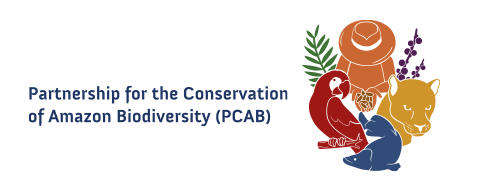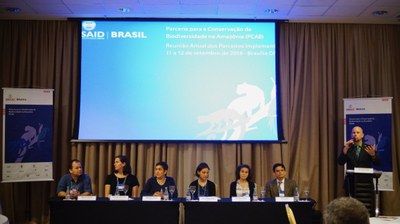PCAB’s partners gather to celebrate progress and discuss alternatives that join development and biodiversity conservation goals
The U.S. Embassy’s Charge d’Affairs William Popp, during his opening remarks emphasized that USAID works via strategic partnerships aligned and complementary to local government policies. The PCAB supports the Amazon Region Protected Areas Program (ARPA) and the Brazilian National Policy of Environmental and Territorial Management of Indigenous Lands (PNGATI). In addition, the PCAB promotes the engagement of the private sector in socio-environmental and sustainable activities in the region.
Popp stressed that the PCAB, signed in 2014, and its results are a reflection of a more than 50-year partnership between the two governments, “The results have brought benefits to both countries and to the world in many different ways.” With the exchange of technical knowledge in the long-lasting partnership with the Forest Service for instance, tangible results have been generated, from forest governance to the expansion of sustainable value chains and conservation enterprises.
According to Michael Eddy, USAID/Brazil, one of the major challenges in the Amazon is “the conception of an economic development model able to ally forest conservation with local development.” He explained that one of the main goals of the meeting was to strengthen partnerships. With that aim, there were sessions to share information on best practices and current/future projects, and to nurture synergies and networking among the different partners. The meeting also had hands-on sessions including: PCAB Theory of Change and the roles each partner plays; the buildup of a coordinated structure for Monitoring & Evaluation (M&E) ; one-to-one sessions with Contracting/Agreement Officer, Ali Nader and Acquisition and Assistance Specialist Cecília Yanez from USAID/Lima; sharing ideas to connect current projects to engaging strategies of the private sector; and a working meeting of press officers and communications professionals among partners.
Results
Since 2017, the PCAB has reached 48 Protected Areas (PAs) in an area of 56 million hectares (13,8 million acres). And 24 of the PAs include implementation in common with the Amazon Region Protected Areas Program (ARPA). USAID/Brazil Environment Director Anna Toness said: “To create protected areas is only the first step, helping fully consolidate them, so that they are fully functioning, conserving resources and generating benefits to local communities, that is the end goal.” That makes the M& E component all the more important because, with consistent indicators, it is possible to measure progress from a baseline and build common goals. Toness also stressed the importance of the entire consortium and network of partners on the ground; for example, the U.S. Forest Service alone works with over 20 other institutions in Brazil.
According to Toness, it is equally necessary to look into what is happening around and outside the PA limits to “seek opportunities to engage and find out what can be done together with the private sector to enable the private sector to become part of the solution.”



